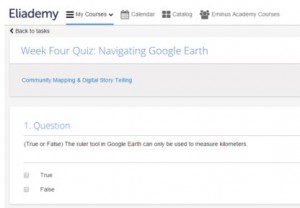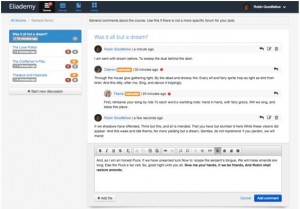Introduction
Learning Management Systems (LMSs) have long dominated online learning courses by offering a platform for educators and students to create, share and manage digital content. New systems enable the integration of data, facilitate interaction and offer ubiquitous access to the extent that LMSs are now also being employed to support more traditional face-to-face learning environments (Porto, 2013). Williamsburg Public School, an elementary school within the Durham District School Board (DDSB) in Ontario, is investigating the possibility of augmenting learning through the use of a LMS. This report aims to explore the affordances and limitations of the specific online platform Eliademy for the middle years section of the school.
In addition to the learning that occurs within face-to-face learning, teachers at Williamsburg Public School are interested in facilitating student learning beyond the physical classroom walls by employing an LMS for the older students at the school in Grades 6-8. Williamsburg Public School most evidently promotes educational technology integration through its digital literacy strategy and a bring-your-own-device (BYOD) program. On a larger scale, the DDSB outlines a number of goals to implement blended and e-learning strategies within the board and offers a variety of online resources for students, teachers, and parents. This paper will cover how Eliademy:
- improves the delivery of learning content
- improves student engagement
- improves student access to learning content
- saves money for the school community
- facilitates student organization (i.e. notifications for deadlines, access to notes, sync calendars, and receive updates on mobile devices)
- provides a holistic view of student progress
The literature review and rubric that follow outline the above criteria in further detail in order to determine the usefulness of the Eliademy LMS in this middle school context.
Literature Review
In the province of Ontario, the Ministry of Education is responsible for giving school boards support for e-learning opportunities while the delivery of e-learning lies with the school boards who are responsible for providing programing, staff, student registrations, and credits to the schools. Through the Ministry, school boards have access to various e-learning tools like the Ontario Educational Resource Bank (OERB) and E-Community Ontario. In 2011, the Ministry of Ontario expanded their support for e-learning to include the ability for school boards to use LMSs to facilitate blended learning (Ontario Ministry of Education, 2012). Since this decision, school boards have been examining other options that suit their local needs. Due to the substantial investment of resources that is required to implement e-learning, school boards need to have the ability to select the most effective LMS to achieve their educational goals. To choose the optimal platform, individual school boards should consider the advantages and disadvantages of the available LMSs as well as take into consideration the needs of all the stakeholders and the resources available to them (Wright et al., 2014). Of the available platforms, school boards must choose from proprietary LMSs (ie. Blackboard, D2L), open source LMSs (ie. Moodle, Sakai), or cloud-based alternatives (ie. Google Classroom or Eliademy).
Until recently, cloud-based alternatives meant using various online tools in an ad-hoc arrangement. For example, one could use Facebook, Google Drive, and Skype to deliver dynamic online learning. However, this method lacks a singular platform to host all of the components of a course together. System integration has become an issue for schools and larger districts as they deal with inconsistent data, time needed to manage user accounts, and technical support issues (Basal, 2010). Fortunately, cloud-based alternatives such as Eliademy are readily available and can provide the means to facilitate e-learning in one secure location.
Cloud-based LMSs further afford advantages such as low cost, or as in the case of Eliademy, the option for no cost. There is also less reliance on local informational technology (IT) departments to manage and support platforms, as support and maintenance is through the cloud-based provider (Wyles, 2015). Additionally, there is an increase in the portability of learning artifacts, which can be accessed once a course is completed (Wright et al., 2014). A further consideration is forecasting trends in technology so that a large investment isn’t made in a technology that will soon be obsolete. Some forecasts see the movement away from proprietary LMSs to systems that are cloud-based within the next five years (Spiro, 2014).
On the other hand, disadvantages of cloud-based tools include providing authentication for a secure environment to monitor enrollment and assessment. The security and privacy is a concern, especially for younger students, as their content can be available to the public. Advertising as a means of revenue for free software can also be a concern as students may be distracted by exposure to advertisements (Wright et al., 2014). Some companies such as Google have even been caught data mining students’ emails, exposing the vulnerability of students’ information on LMSs (Herold, 2015).
The ultimate goal in implementing an LMS should be to facilitate student achievement. According to a U.S. Department of Education report, “Students who took all or part of their class online performed better, on average, than those taking the same course through traditional face-to-face instruction” (Means et al., 2010). Part of the report focuses on K-12 use of online learning and found that out of the five studies, four of them demonstrated better achievement than students in exclusively face-to-face environments. The meta-analysis study found that “instruction combining online and face-to-face elements had a larger advantage relative to purely face to-face instruction than did purely online instruction” (Means et al., 2010). A more recent study found that along with increased motivation, students engaged in discussion online had the potential to increase their writing skills, encourage critical thinking, and demonstrate more systematic writing (Wickadee, 2014).
Evaluation of Eliademy
Evaluation of Eliademy LMS in achieving goals of Durham District School Board
Student achievement. The use of Eliademy has the capability to orchestrate an increase in student achievement. Such increases in achievement may occur when students are enabled to access their course materials anytime and anywhere while also maintaining constant peer-to-peer communication to build knowledge in their learning community. Second, the platform could lead to a more consistent delivery of content from teachers across various grades and subjects due to the ability for files, images, videos, and tasks to be easily shared. Third, since students find it difficult to save their work in the correct place on networks, saving in a cloud-based program such as Eliademy can reduce the amount of “lost work.” Fourth, learning outlines can be communicated much more clearly to students and parents when posted on an online platform. Fifth, students have the ability to work at their own pace and process new material in a more differentiated manner when content is posted through an LMS. Finally, the online platform and variety of assessment tools allow teachers to provide individualized feedback instantaneously and encourage students to show their learning in various ways.

Example of embedded quiz function in Eliademy LMS.
Student well-being. Since well-being is often correlated with student achievement, the use of Eliademy affords a high increase in student achievement. Improved student organization as detailed above and online collaborative learning may help to reduced anxiety when compared to face-to-face learning. The DDSB believes that technology should be used at the point of instruction as exposure to such technologies will prepare students for the future technology-reliant workforce. Furthermore, students’ work and identities are protected from the public to contribute to students’ well-being.
Student engagement. Eliademy affords a high increase in student engagement due to accessibility on a wide range of devices (ie. phones, tablets, laptops), a new technological way to promote peer-to-peer interactivity through collaborative online discussion forums and file sharing, and the ability to create learner-centered assignments.

Example of embedded discussion forum in Eliademy LMS.
Inspired leadership. We feel that the Eliademy platform can provide considerable improved in inspired leadership. Eliademy improves the consistency of content delivery because teachers can create, share and manage courses. Furthermore, Eliademy tracks time on task, affords the monitoring of group discussions, and allows a holistic view of student progress through the online grading system. These features along with the ease of use will inspire teachers to implement Eliademy in their online or blended classrooms and teach others how to do the same.
Sustainability. Eliademy shows a high degree of sustainability because it is a cloud-based alternative to expensive learning management systems that is user-friendly and easily accessible on many platforms. It is considerably cheaper than most LMSs, including Desire to Learn (D2L) which can cost a district millions of dollars to implement. Additionally, LMSs can reduce the amount of paper usage at a school, consequently saving money and the environment.
Conclusion
Overall, Eliademy could offer an affordable, sustainable, and accessible learning platform for the middle school of Williamsburg Public School. The many features provided through this cloud-based LMS – including calendar syncing, access to online multimedia, discussion and collaboration, and tasks and quizzes – have the potential to foster student success and achievement and ultimately engage students in twenty-first century learning. This user-friendly LMS model further provides teachers with a holistic understanding of student progress through its “Learner’s Analytics” functions. The features and functions of Eliademy as an LMS support the e-learning goals of the school board by encouraging a blended learning approach to education and opportunities for e-learning. The accessibility of this platform and its availability for use with a range of devices also facilitates the BYOD initiative outlined by Williamsburg Public School. Furthermore, the low cost associated with implementing Eliademy into the middle school context creates a greater sense of sustainability and affordability allowing this LMS to be implemented in schools across the DDSB.
References
Barbour, M. (2012). State of the nation: K–12 online learning in Canada. International Association for K–12 Online Learning.
Basal, A., Steenkamp, A.L., (2010). A saas-based approach in an e-learning system. International Journal of Information Science and Management, Special Issue January /June.
Herold, B. (2014). Google Under Fire for Data-Mining Student Email Messages. Education Week. Retrieved from http://www.edweek.org/ew/articles/2014/03/13/26google.h33.htm
Means, B., Toyama, Y., Murphy, R., Bakia, M. & Jones, K. (2010). Evaluation of evidence-based practices in online learning: A meta-analysis and review of online learning studies. U.S. Department of Education. Office of Planning, Evaluation, and Policy Development, Policy and Program Studies Service. Retrieved from http://www2.ed.gov/rschstat/eval/tech/evidence-based-practices/finalreport.pdf
Ontario Ministry of Education (2012). E-learning Ontario: The sky is the limit! Digital education – Kindergarten to Grade 12. Retrieved from: http://www.edu.gov.on.ca/elearning/strategy.html
Porto, S. (2013, December 13). The Uncertain Future of Learning Management Systems. The Evolllution. Retrieved from http://evolllution.com/opinions/uncertain-future-learning-management-systems
Sandsford, D. & Hall, S. (2014). Digital Citizenship Bootcamp. Durham District School Board Strategic Goals. Retrieved from
http://ddsb.ca/AboutUs/StrategicGoals/BoardImprovementPlan/Documents/2015-2018_BIP.pdf#search=bip
Spiro, K. (2014, February 25). 5 e-learning trends leading to the end of the learning management systems. eLearning Industry. Retrieved from http://elearningindustry.com/5-elearning-trends-leading-to-the-end-of-the-learning-management-system
Tabscott, D. (2009, August 20). Online learning boosts performance. Grownupdigital. Retrieved from http://www.grownupdigital.com/archive/index.php/2009/08/online-learning-boosts-student-performance
Walker, L. R., & Shepard, M. F. (2011). Phenomenological investigation of elementary school teachers who successfully integrated instructional technology into the curriculum. Journal of Educational Research and Practice, 1(1), 23–35
Wichadee, S. (2014). Students’ learning behavior, motivation and critical thinking in learning management systems. Journal of Educators Online, 11(3), 1-21.
Wright, C.R., Lopes, V., Montgomerie, T.C., Reju, S.A. & Schmoller S. (2014, April 21). Selecting a learning management system: Advice from an academic perspective. EduCause Review. Retrieved from http://www.educause.edu/ero/article/selecting-learning-management-system-advice-academic-perspective
Wyles, R. (2015, January 2). Learning Management Systems 2015 – 12 Trends to watch. Totara. Retrieved from: https://www.totaralms.com/index.php?q=blog/learning-management-systems-2015-12-trends-watch
